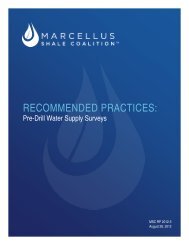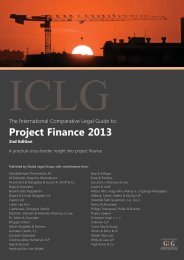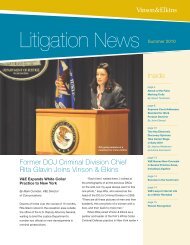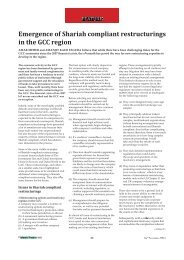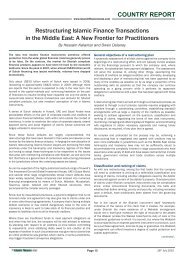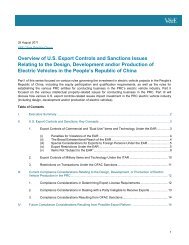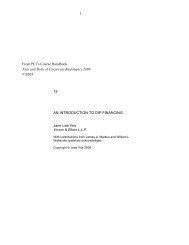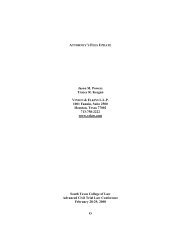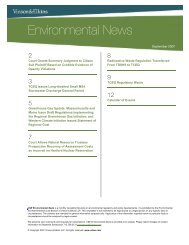TEXAS TRANSNATIONAL LAW QUARTERLY - Vinson & Elkins LLP
TEXAS TRANSNATIONAL LAW QUARTERLY - Vinson & Elkins LLP
TEXAS TRANSNATIONAL LAW QUARTERLY - Vinson & Elkins LLP
Create successful ePaper yourself
Turn your PDF publications into a flip-book with our unique Google optimized e-Paper software.
<strong>TEXAS</strong> <strong>TRANSNATIONAL</strong> <strong>LAW</strong> <strong>QUARTERLY</strong> – June 2009property rights. Only developing countries thathave ratified an international treaty, have put inforce national policies, and have undertaken“nationally appropriate” GHG mitigation activitiesthat will achieve substantial GHG reductions areeligible for funding. The Secretary of State, inconsultation with the interagency group, isauthorized to select eligible projects to receivefunding.Assistance will be allowances allocated for cleantechnology activities in the form of bilateralassistance to multilateral funds or institutions.Such activities include those that achievesubstantial reductions in GHG emissions and/orachieve capacity building. Sample projectsinclude: CCS; renewable electricity generation;projects that increase the efficiency of electricityconsumption, distribution, or transmission; andprojects that reduce transportation sectoremissions through increased efficiency or use offuels that have lifecycle emissions that aresubstantially lower than those attributable tofossil fuel-based alternatives.Adapting to Climate ChangeSubtitle E establishes an interagency committeeconsisting of representatives from variousfederal agencies conducting global changeresearch to ensure an integrated federalresponse to the impacts of climate change. Theinteragency committee is directed to undertakevulnerability assessments, coordinate federaland international activities with global changeresearch activities, and serve as the forum forthe development of the “National Global ChangeResearch and Assessment Plan.” ThePresident will develop the Plan, which willcontain global change research andassessment. The President will also establishan interagency United States Global ChangeResearch Program, lead by the Office ofScience and Technology Policy.The Under Secretary of Commerce for Oceansand Atmosphere, building upon the resources ofthe National Weather Service and the weatherand climate programs of the National Oceanicand Atmospheric Administration (NOAA), isdirected to establish a National ClimateService (NCS). The NCS will coordinate NOAAprograms and serve as a clearinghouse toprovide federal, state, local, and tribalgovernment decision-makers with access toinformation relating to the impacts of climatechange and adaption to such impacts. Eachfederal agency 7 is directed to review climateimpacts on matters within its jurisdiction anddevelop plans for addressing those impacts.The bill also establishes a climate changeadaptation fund to provide federal support forstate, local, and tribal projects to reducevulnerability to climate change impacts. Inaddition, the bill requires the Secretary of Healthand Human Services to promulgate a nationalstrategy for mitigating the impacts of climatechange on public health. The bill furtherestablishes an interagency Natural ResourcesClimate Change Adaption Panel to address theimpacts of climate change on natural resources.A special fund will be created to carry outadaptation activities related to natural resources.Finally, to address international adaptationissues, the bill creates an International ClimateChange Adaptation Program within USAID toprovide U.S. assistance to help the mostvulnerable developing countries adapt to climatechange.Authors: Christopher Carr, Larry Nettles, andGregory Staple are attorneys at the Houstonoffice of <strong>Vinson</strong> & <strong>Elkins</strong> <strong>LLP</strong>. They can becontacted via e-mail through www.velaw.com.1 This article contains excerpts from <strong>Vinson</strong> & <strong>Elkins</strong> <strong>LLP</strong>’slarger publication on the topic, which is available through theauthors or by contacting Wayne Harris, atwharris@velaw.com.2 The other GHGs are methane (CH4), nitrous oxide (NOX),sulfur hexafluoride (SF6), and hydrofluorocarbon, aperfluorocarbon and nitrogen trifluoide. The EPA is alsogiven discretion to bring other anthropogenic gases underthe new program.3 After 2017, however, a covered entity must hold 1.25international offsets in lieu of every one emission allowance.4 Significantly, however, if an entity substitutes a regulardomestic offset credit for a term offset credit, the use of thatdomestic credit is not subject to the 50 percent limit on useof such credits. See Section 722(d)(2)(D).5 Under Title I, FERC also will police the market for the newfederal renewable energy certificates (RECs) issued by theagency.6 See Part IV, Subtitle E of Title III at Section 358.7 Including NOAA, EPA, the Departments of Agriculture,Commerce, Defense, Energy, Health and Human Services,Homeland Security, Housing and Urban Development,Interior, and Transportation, as well as the Army Corps ofEngineers, the Centers for Disease Control, FEMA, NASA,and the United States Geological Survey.- 19 -




